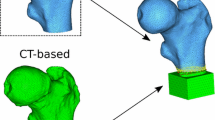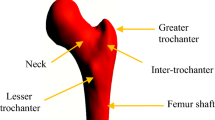Abstract
This paper presents an analysis of predicting the load-bearing capacities of human femurs using quantitative computer tomography (QCT)-based beam theory. Cross-sectional images of 12 human cadaver femurs (intact bones, age: 39–77 years; male = 8, female = 4) were scanned in conjunction with a calcium hydroxyapatite phantom which has five chambers of known densities. The apparent densities obtained from the scans were used to evaluate the Young’s modulus (E) by applying the established empirical relationships. The fracture load of a configuration that simulated single-legged stance was measured experimentally and compared with the predicted failure load using a composite beam theory, plane stress model of the femur. In this model, the failure was assumed to occur at the weakest cross-section through the bone determined from QCT-based structural analysis. In contrast to the other experimental investigations, the setup used in this study considers the entire length of a human femur and also incorporates a novel mechanical jig to mimic the realistic physiological scenario. In one of our earlier studies, simulated lytic defects of varying size were created at the inter-trochanteric region of femurs and their load-bearing capacities were calculated based on their structural properties. Both the results obtained from the current study as well as the ones from our previous study were used to assess the viability of the methodology. A high degree of correlation was observed when the predicted failure loads obtained from the intact femurs and previously studied defective femurs were compared with the ex vivo fracture loads. The coefficients of determination (R 2) of QCT-derived predicted loads with respect to the measured failure loads were 0.80 for the intact femurs and 0.87 for the defective femurs. The results suggest that the QCT-derived beam analysis provides a viable approach for the assessment of load-bearing capacity in various clinical scenarios.











Similar content being viewed by others
Notes
DICOM is a type of medical imaging file that contains both a header (which stores information about the patient’s name, the type of scan, the image dimensions, etc.), as well as all of the image data.
References
Aalam, M. Implementation of McMurray displacement in adduction osteotomy with AO-instruments. Z Orthop Ihre Grenzgeb 115:797–42; 1977.
Beals, R. K., Lawton, G. D., and Snell, W. E. Prophylactic internal fixation of the femur in metastatic breast cancer. Cancer 28:1350–1354; 1971. doi:10.1002/1097-0142(1971)28:5<1350::AID-CNCR2820280539>3.0.CO;2-6
Bland, J. M., and Altman, D. G. Statistical methods for assessing agreement between measurement. Biochimica Clinica 11:399–404; 1987.
Burghardt, A. J., Kazakia, G. J., Laib, A., and Majumdar, S. Quantitative assessment of bone tissue mineralization with polychromatic micro-computed tomography. Calcif Tissue Int. 83:129–138; 2008. doi:10.1007/s00223-008-9158-x
Capanna, R., Dal Monte, A., Gitelis, S., and Campanacci, M. The natural history of unicameral bone cyst after steroid injection. Clin Orthop 166:204–211; 1982.
Cheal, E. J., Spector, M., and Hayes, W. C. Role of loads and prosthesis material properties on the mechanics of the proximal femur after total hip arthroplasty. J Orthop Res 10:405–22; 1992. doi:10.1002/jor.1100100314
Fidler, M. Incidence of fracture of metastases in long bones. Acta Orthop Scand 52:623–627; 1981.
Gray, H., Bannister, L. H., Berry, M. M., and Williams, P. L. Gray’s anatomy: the anatomical basis of medicine & surgery. New York: Churchill Livingstone; 1995.
Habermann, E. T., Sachs, R., Stern, R. E., Hirsh, D. M., and Anderson, W. J. J. The pathology and treatment of metastatic disease of the femur. Clin Orthop Relat Res 169; 1982.
Hamer, A. J., Strachan, J. R., Black, M. M., Ibbotson, C. J., Stockley, I., and Elson, R. A. Biochemical properties of cortical allograft bone using a new method of bone strength measurement. A comparison of fresh, fresh-frozen and irradiated bone. J Bone Joint Surg Br 78:363–368; 1996.
Hipp, J. A., Springfield, D. S., and Hayes, W. C. Predicting pathologic fracture risk in the management of metastatic bone defects. Clin Orth and Rel Res 312:120–135; 1995.
Hong, J., Cabe, G. D., Tedrow, J. R., Hipp, J. A., and Snyder, B. D. Failure of trabecular bone with simulated lytic defects can be predicted non-invasively by structural analysis. J Ortho Res 22:479–486; 2004. doi:10.1016/j.orthres.2003.09.006
Kaneko, T. S., Pejcic, M. R., Tehranzadeh, J., and Keyak, J. H. Relationships between material properties and CT scan data of cortical bone with and without metastatic lesions. Med Eng Phys 25:445–454; 2003. doi:10.1016/S1350-4533(03)00030-4
Keaveny, T. M., Guo, X. E., Wachtel, E. F., McMahon, T. A., and Hayes, W. C. Trabecular bone exhibits fully linear elastic behavior and yields at low strains. Journal of Biomechanics 27:1127–36; 1994. doi:10.1016/0021-9290(94)90053-1
Keene, J., et al. Metastatic breast cancer in the femur: A search for the lesion at risk of fracture. Clinical Orthopaedics and Related Research 203:282–288; 1986.
Keyak, J. H., Kaneko, T. S., Tehranzadeh, J., and Skinner, H. B. Predicting proximal femoral strength using structural engineering models. Clin Orthop Relat Res 437:219–228; 2005. doi:10.1097/01.blo.0000164400.37905.22
Lee, T. Predicting failure load of the femur with simulated osteolytic defects using noninvasive imaging technique. Ann Biomed Eng 35:642–650; 2007. doi:10.1007/s10439-006-9237-y
Lee, T., B. W. Schafer, W. P. Segars, F. Eckstein, V. Kuhn, and T. J. Beck. A simulation of age-related geometric changes to the femoral neck cortex on the susceptibility to local buckling. Ann. Biomed. Eng., In Review, 2009.
Markolf, K. L., Graff-Radford, A., and Amstutz, H. C. In vivo knee stability. A quantitative assessment using an instrumented clinical testing apparatus. J Bone Joint Surg Am 60:664–674; 1978.
Mase, K., Toriwaki, J., and Fukumura, T. Modified digital voronoi diagram and its applications to image processing (in Japanese). IEICE Trans J64-D:1029–103; 1981.
Menck, H., Schulze, S., and Larsen, E. Metastatic size in pathologic femoral fractures. Acta Orthop Scand 59:151–154; 1988.
Michaeli, D. A., Inoue, K., Hayes, W. C., and Hipp, J. A. Density predicts the activity-dependent failure load of proximal femora with defects. Skeletal Radiol 28:90–95; 1999. doi:10.1007/s002560050480
Mitterbauer, C., Kramar, R., and Oberbauer, R. Age and sex are sufficient for predicting fractures occurring within 1 year of hemodialysis treatment. Bone 40:516–521; 2007. doi:10.1016/j.bone.2006.09.017
Pulkkinen, P., Partanen, J., Jalovaara, P., and Jamsa, T. Combination of bone mineral density and upper femur geometry improves the prediction of hip fracture. Osteoporos Int. 15:274–280; 2004. doi:10.1007/s00198-003-1556-3
Rice, J. C., Cowin, S.C., and Bowman, J.A. On the dependence of the elasticity and strength of cancellous bone on apparent density. J. Biomech. 21:155–168; 1988. doi:10.1016/0021-9290(88)90008-5
Scheid, V., Buzdar, A. U., Smith, T. L., and Hortobagyi, G. N. Clinical course of breast cancer patients with osseous metastasis treated with combination chemotherapy. Cancer 58:2589-2593; 1986. doi:10.1002/1097-0142(19861215)58:12<2589::AID-CNCR2820581206>3.0.CO;2-O
Snyder, S. M., and Schneider, E. Estimation of mechanical properties of cortical bone by computed tomography. J Orthop Res 9:422–431; 1991. doi:10.1002/jor.1100090315
Thomson, R. Impending fracture associated with bone destruction. Orthopedics 15:547–550; 1992.
Thorpe, D. L., Knutsen, S. F., Beeson, W. L., and Fraser, G. E. The effect of vigorous physical activity and risk of wrist fracture over 25 years in a low-risk survivor cohort. J Bone Miner Metab 24:476–483; 2006. doi:10.1007/s00774-006-0715-y
Whealan, K. M., Kwak, S. D., Tedrow, J. R., Inoue, K., and Snyder, B. D. Noninvasive imaging predicts failure load of the spine with simulated osteolytic defects. J Bone Joint Surg Am 82:1240–1251; 2000.
Wilkins, R., Sim, F., and Springfield, D. Metastatic disease of the femur. Orthopedics 15:621–630; 1992.
Acknowledgment
This work was supported by the Academic Research Funding (AcRF #R397-000-034-112) from the Ministry of Education (MoE), Singapore.
Author information
Authors and Affiliations
Corresponding author
Rights and permissions
About this article
Cite this article
Lee, T., Pereira, B.P., Chung, YS. et al. Novel Approach of Predicting Fracture Load in the Human Proximal Femur Using Non-Invasive QCT Imaging Technique. Ann Biomed Eng 37, 966–975 (2009). https://doi.org/10.1007/s10439-009-9670-9
Received:
Accepted:
Published:
Issue Date:
DOI: https://doi.org/10.1007/s10439-009-9670-9




